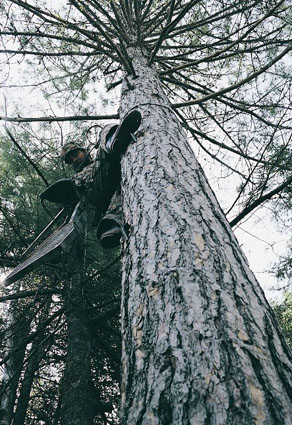 After you select a tree, don’t arbitrarily set your stand at a specified height; remembering the “3 bears” philosophy will allow you to take full advantage of any available cover. |
As I consider the many close encounters I’ve had with worthy bucks over the years, the one area I continually try to improve on is treestand setup. I’m not necessarily thinking about locating the quintessential tree for the quintessential 20-yard shot. Instead, I’m thinking along the lines of fine-tuning an execute-friendly tree. If you’re picking up on my brain waves, you know that merely getting close isn’t enough. That’s just the first chapter. Here are a few more paragraphs to the book on treestand trickery.
Vantage Means Advantage
When the folks at Realtree somehow managed to trademark the name Advantage for their camouflage pattern, they knew what they were doing. Indeed, “advantage” is what usually defines the fine line separating failure from success. And that’s what big league treestanding is all about. It starts with height and it ends with sight.
If a deer spots you before you spot it, you’ve given up the advantage. What good is height if you don’t tend to the details necessary for exploiting it? Before you set your treestand, take plenty of time to view the landscape. Ask yourself if an extra couple of feet will really improve long-range vision. Usually it will...up to a point. The key is knowing when you’ve reached that propitious point.
The process I now use was adapted from a late bowhunting buddy, Bill Nelson. Nobody could “put the move” on bucks quite like Nelson, who was instrumental in teaching me the value of “3 bears treestanding”—not too low, not too high, but just right. Nelson would habitually set a minimum of 15 treesteps and then scan the landscape at each step like an owl on a telephone wire to evaluate the view. This is how to tell if tree crown canopy and/or understory cover negatively influences a specific treestand height. For example, the “3 bear height” on one of Nelson’s favorite trees was precisely 18 feet, while it was 27 feet in another and only 14 feet in another.
Another critical factor is balancing long-range sight against short-range sight. Few tree locations provide both. I’m reminded of a hardwoods ridge line banking against a tag alder swamp in northern Minnesota. It provided a grand view of deer working the bottomlands a football field away, but the steep slope kept my nerves raspy raw—a buck could pop over the rise and be on top of me before I could say “buck fever.”
Next: Jack Be Nimble, Backwards Is Better






